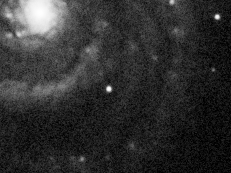Forum Replies Created
-
AuthorPosts
-
 David SwanParticipant
David SwanParticipantYes, I am sure that is right! It will be interesting to see what happens. There was a suggestion of spectroscopy in the article too, wasn’t there? As well as giving people a peek through the scopes at bright targets, I think the operators should deploy the latest EAA software for showing essentially-live pics to a wider audience. Lucky imaging of planets and near-live imaging of asteroids, comets, globulars etc is possible even from that location. I know from my interactions with the public that people are amazed by what’s possible now with the right hardware and software.
 David SwanParticipant
David SwanParticipantThis object has gone ‘mainstream’, with articles in New Scientist (and the Daily Mail). The New Scientist article has a floating cow superimposed on a star field, in reference to the transient ID.
 David SwanParticipant
David SwanParticipantAn excellent image Peter – seems fitting that there should be one of the sun posted up here at the summer solstice. And there are a few active regions visible on the sun too, which is a bonus.
 David SwanParticipant
David SwanParticipantThanks Robin. I didn’t know that a CV in outburst has that spectral appearance. Hopefully with further work things will get cleared up as much as possible.
 David SwanParticipant
David SwanParticipantThanks Robin – makes sense.
 David SwanParticipant
David SwanParticipantVery nice. In the medium term I think I’ll look at buying a short focal length refractor. It is lovely to have a wide field of view.
 David SwanParticipant
David SwanParticipantIn addition to the maximum stacked image on my member’s page, I have created a short video from the same frames. It runs at 5fps. https://1drv.ms/u/s!Agvxu8wNOxpAcskxKKX5lQZyCh4
 David SwanParticipant
David SwanParticipantI’ll be looking as often as I can. I had trouble getting access to this patch of sky too!
 David SwanParticipant
David SwanParticipantV392 Per is noticeably dimmer than the nearby TYC star now. Here’s an image from this eve (13 May) – UV/IR block only. Time in filename is UT. I have measured the mag as 9.8 (CV).
 David SwanParticipant
David SwanParticipantI am perhaps extending this frivolous sidetrack beyond its natural life … notwithstanding this, the New Scientist for a long time ran letters on nominative determinism in its Feedback section. Weedon and Splatt published lots of urology research.
 David SwanParticipant
David SwanParticipantI took some frames through the StarAnalyser 100 this evening. I’m pleased to see that my spectrum looks very like yours – the expert’s – but of course mine is lower res. The Halpha emission was indeed striking in the images!
1 May 2018 at 9:26 pm in reply to: Question: proper motion of star, solar system object, artefact or other? #579409 David SwanParticipant
David SwanParticipantThanks Robin. Hopefully the nova will remain bright enough till the weekend for me to deploy my C8 + StarAnalyser on it. I was a bit tired yesterday to attempt some low res spectroscopy. Your stuff looks great – I look forward to seeing how the spectrum evolves.
 David SwanParticipant
David SwanParticipantUnfortunately my experience is that fate is rarely on my side on these sorts of matters!
 David SwanParticipant
David SwanParticipantWow, it is bright!
 David SwanParticipant
David SwanParticipantThanks for pointing this out – and I see Denis has put an image of the nova and field on his member’s page. Time to get my StarAnalyser out!
 David SwanParticipant
David SwanParticipantYes, it will be great to see something in white light again. Latest SOHO image is promising…
 David SwanParticipant
David SwanParticipantYes, of course it could indeed be real. I just posted my image up in case it turned out to be a longer-lived phenomenon. Point meteor may be a good candidate. Transparency last night was excellent.
 David SwanParticipant
David SwanParticipant
50 x 10s frames, median stack, midpoint of imaging run: 20:40 GMT. Unfortunately no bright signal at the same position.
 David SwanParticipant
David SwanParticipantI’ve scrutinised my 10th March image of M51 and indeed there’s no evidence of this transient. I’ll try to get some images this evening. It’s clear skies in Tynemouth at the moment, but of course this is unlikely to remain the case as the sky darkens! David
 David SwanParticipant
David SwanParticipantI have some experience with this.
The latest version of the Nexstar + handset has a serial to USB converter built in. The handset connects to the mount via the telephone-style cable, and you connect your PC to the Nexstar + handset with a mini USB cable.
IMHO, the free Celestron handset emulator software that runs on the PC is dreadful. I have also been unimpressed by other software that is capable of controlling the scope (pointing model, goto) such as Skysafari.
I prefer being at the scope, eyepiece in, and aligning and finding objects with the handset. I then swap out the star diagonal plus eyepiece with the camera when all is good.
So you can do operation via PC, but the Nexstar mount is not up to remote control like the very much more expensive mounts such as the Paramount series.
-
AuthorPosts
